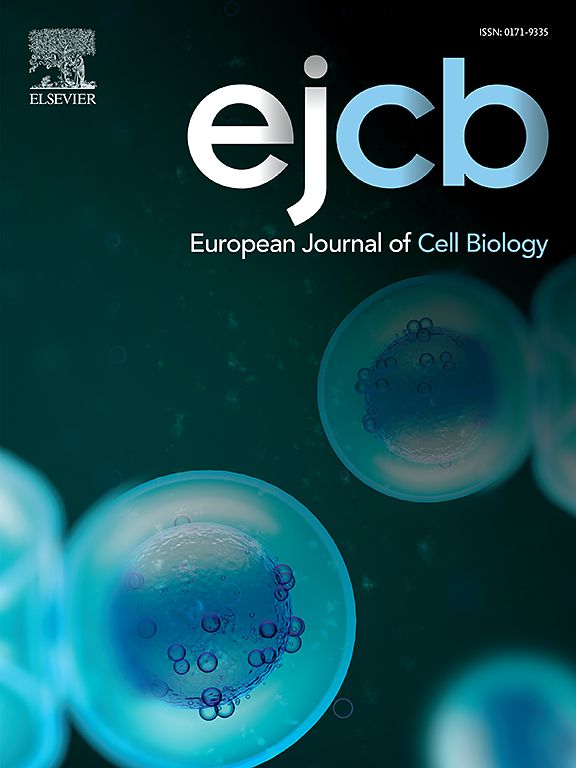Structure and function of the keratin 17 tail domain associated with keratin intermediate filament organization
IF 4.3
3区 生物学
Q2 CELL BIOLOGY
引用次数: 0
Abstract
Keratins are the largest subgroup of intermediate filament proteins, forming 10-nm filaments from type I/II heterodimers, and occur primarily in epithelial cells. Keratin 6 (K6; type II) and Keratin 17 (K17; type I) show a complex expression pattern that includes induction following stress and in several diseases, including carcinomas. K17 is being used as a biomarker for several types of cancer. K6 and K17 sequences are respectively highly homologous to K5 and K14, which are expressed in the progenitor compartment of epidermis and related epithelia. The mechanical support roles of the K6/K17 and K5/K14 pairing require 10 nm filament assembly and the subsequent lateral association of these filaments to form thicker bundles. Previous studies showed that the non-helical tail domain of K14 is dispensable for 10 nm filament assembly but essential to the bundling of K5/K14 filaments. Whether the K6/K17 pairing undergoes bundling, and whether the tail domain of K17 plays a role, is unknown. Here, we use sedimentation assays and electron microscopy to show that, when paired with K6, tailless K17 forms filaments that do not readily bundle. Nuclear magnetic resonance analysis revealed that the isolated K17 tail domain is an intrinsically disordered region (IDR). Follow-up studies with mutant K17 tail constructs suggest that IDR-like tail domains of keratins can form a curved local structure required for bundling and interact dynamically with other regions of keratin filaments in a flexible and heterogeneous manner.
与角蛋白中间丝组织相关的角蛋白17尾部结构域的结构和功能。
角蛋白是中间丝蛋白中最大的亚群,由I/II型异源二聚体形成10 nm的丝,主要存在于上皮细胞中。角蛋白6 (K6, II型)和角蛋白17 (K17, I型)表现出复杂的表达模式,包括应激诱导和包括癌在内的几种疾病。K17被用作几种癌症的生物标志物。K6和K17序列分别与K5和K14高度同源,表达于表皮及相关上皮的祖细胞室。K6/K17和K5/K14配对的机械支撑作用需要10 nm的纤维组装和随后这些纤维的横向结合以形成更厚的束。先前的研究表明,K14的非螺旋尾结构域对于10 nm的细丝组装是必不可少的,但对于K5/K14细丝的捆绑却是必不可少的。K6/K17配对是否经历了捆绑,以及K17的尾部结构域是否起作用,目前尚不清楚。在这里,我们使用沉降试验和电子显微镜来显示,当与K6配对时,无尾K17形成不容易捆绑的细丝。核磁共振分析表明,孤立的K17尾部结构域是一个内在无序区(IDR)。对突变体K17尾部结构的后续研究表明,角蛋白idr样尾部结构域可以形成弯曲的局部结构,并以灵活和异质的方式与角蛋白细丝的其他区域动态相互作用。
本文章由计算机程序翻译,如有差异,请以英文原文为准。
求助全文
约1分钟内获得全文
求助全文
来源期刊

European journal of cell biology
生物-细胞生物学
CiteScore
7.30
自引率
1.50%
发文量
80
审稿时长
38 days
期刊介绍:
The European Journal of Cell Biology, a journal of experimental cell investigation, publishes reviews, original articles and short communications on the structure, function and macromolecular organization of cells and cell components. Contributions focusing on cellular dynamics, motility and differentiation, particularly if related to cellular biochemistry, molecular biology, immunology, neurobiology, and developmental biology are encouraged. Manuscripts describing significant technical advances are also welcome. In addition, papers dealing with biomedical issues of general interest to cell biologists will be published. Contributions addressing cell biological problems in prokaryotes and plants are also welcome.
 求助内容:
求助内容: 应助结果提醒方式:
应助结果提醒方式:


